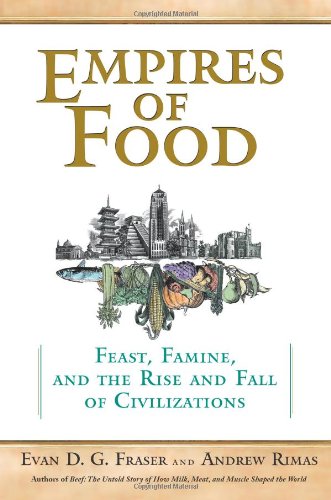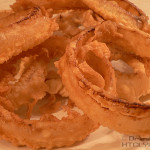Reviewing children’s movies is hard. As an adult, you’ve seen all the storylines before. Before the movie is half over — if it even takes that long — you know everything that’s going to happen.
But the kids don’t. They haven’t seen it all before. They don’t know that the hero always wins. They didn’t know Simba was going to return and become the Lion King. They didn’t know Han Solo was going to show up again in the last act. (What, you didn’t know Star Wars was a kids’ movie?)
Sometimes historians must feel like film critics, because they’ve also seen it all before. And like Mark Twain (probably) said, “History doesn’t repeat itself, but it rhymes.” That’s the premise of Empires of Food: Feast, Famine, and the Rise and Fall of Civilizations, by Evan D.G. Fraser and Andrew Rimas.
They show that throughout history every empire has expanded — was able to expand — because of successful agriculture. And that empires always expand until they have out-stripped current agricultural technology, leading to a sudden collapse of the system and massive hunger and death.
At this point you’re probably starting to see some foreshadowing. Maybe starting to wonder, “Okay, so where are we today on this boom-and-bust cycle?” Let’s put it this way: If this were a horror movie, you’d be hearing ominous music about now.
The Prequel
One of the first human cities was Uruk, between the Tigris and Euphraties rivers. What Uruk had going for it was a steady supply of excess grain. This was the first of three factors Fraser and Rimas identify as the necessary conditions for an empire:
- The ability to produce more food than the farmers need to eat, so it can be sold at a profit.
- The ability to store that surplus long enough to trade it.
- Some way to transport the surplus to whoever you want to trade it with.
Again and again throughout history, cultures develop agriculture systems that produce a local surplus. This usually starts with fertile land and gentle climate, but soon progresses to irrigation, use of fertilizer, clearing forest land for additional crop space, and expansion into previously unused land — even if another culture was already using it.
Of course by that time there’s already a system in place for protecting the food, the trading routes, and the profits from it. There’s a good argument that the first standing armies were created to protect trade routes from bandits and pirates.
The Second Act
When a culture moves from hunter-gatherer through subsistence farming and finally to profit-based agriculture, there’s a change not just in how they produce food, but in what food they produce. Specialization leads to higher profits through increased efficiency. Land that is best suited to growing wheat, for instance, will only be planted with wheat.
From a system-level perspective, this is good. If it’s cheaper to buy imported wheat than to grow it yourself, that’s exactly what market forces say should happen. This theory isn’t much comfort to the local wheat farmer who just got priced out of the market.
The solution has always been the same: If you can’t grow basic commodities profitably, produce something rare and expensive. Things like wine, cheese, livestock. Sell these high-priced goods, and buy wheat with the profits. Everyone wins.
Dun, Dun, Dunnnnn …
Then there’s a drought. Or a late frost wipes out the seedlings and it’s too late in the season to plant again. For the people growing wheat this is an economic disaster. Rather than selling their stored grain this season they have to keep it all home to feed themselves. For the people who were expecting to buy that wheat it’s not just a financial problem. They starve.
And “efficient” systems are much more susceptible to these sudden shortfalls.
A “just enough, just in time” production and supply chain makes sense to a company selling plastic widgets, but it’s a terrible way to run a food system.
When every part of a system is at maximum efficiency, and all the produce is consumed as soon as it’s available, there’s no buffer. How bad can this get?
By the end of the thirteenth century, margins between supply and demand had thinned to a razor’s breadth. A decline of 10 percent in a year’s harvest spelled hunger; a loss of 20 percent of the harvest meant famine.
And then the financial system imploded. For centuries, bankers in Siena had loaned heavily to Europe’s royal houses, financing wars and armies. They overextended themselves on architecture, cavalry, and crusades, so when harvests dropped and manors or cities defaulted on their loans, the banks collapsed. In 1298, the Gran Tavola bank of the Bonsignori, the Rothschilds of their day, failed. Rents soared as landlords struggled to pay their debts. Work on Siena’s great cathedral came to a stop. Florentine banks rushed to grab business from the Sienese, but they didn’t have much better luck. Defaulting had become a medieval habit.
Take out the names and dates, and doesn’t that sound like last year’s headlines? Not good enough? Okay, here’s a figure that is from last year’s headlines. (Or it would be if anyone were reporting on it.)
[N]utrients leaking off cropland have spoiled 37 percent of all American surface water, rendering it undrinkable by humans and unfit for fish.
That, unfortunately, is another one of the repeating themes from food empires: Intensive agriculture eventually ruins the land and the water supply.
Don’t We Ever Learn?
You’d think if this is an old story we’d have learned something by now. Maybe we’d see it coming and do something about it. Gosh, you’re an optimist, aren’t you?
Okay, that’s not fair. We have learned a few lessons.
The modern “Renaissance faire” with its bespectacled wenches and roast turkey legs has two things in common with genuine medieval fairs: ferocious profiteering and regulation.
Yes, we’ve learned how to squeeze more profit out before the system falls over. Don’t believe it?
Bereft of African produce, a true famine struck the city of Rome in 383. The authorities tried to stem the panic by expelling “strangers,” meaning useless characters like Greek scholars and artists (they did, however, make an exception for actors and for three thousand dancing girls).
Yup, sounds familiar.
Even worse, there are lessons we’ve learned and forgotten. Back to ancient Rome again.
While the urban lower classes survived on bread, they didn’t thrive. An all-wheat diet lacks protein, calcium, and vitamins A, C, and D. Children, in particular, develop rickets if they eat nothing more than grain. So while the Romans never puzzled over the geometry of the food pyramid, they did understand that a diet consisting solely of bread and barley causes physical degeneracy, and they also understood that eating fish and olives prevented and healed it.
Maybe they had an advantage. Since they didn’t know about vitamins and micronutrients all they had to go on was overall diet and observed outcomes. So they saw that people who ate only grains (carbohydrates in current terminology) weren’t healthy, while people who ate fish and oil were healthy. Some of us are starting to re-learn that one, but the official line from “authorities” still says we should be eating less animal products and more grains.
What Now?
The cautionary tale Fraser and Rimas tell is stronger than the conclusion. They suggest that we know what we need to do, but don’t have the will.
All the evidence tells us that industrial farming is unsustainable, but the world has been bribed into blindness by a ham sandwich.
They make some good points about various movements seeking to solve the problem. For instance, they support the idea of applying the true cost of food production — including environmental damage and health problems — to the sale price.
Grass-fed beef, organic beets, Fair Trade coffee — their prices aren’t more expensive, they’re simply more honest.
But they still get stuck in some of the assumptions of the current system.
Meat, for example, is profligate with fossil fuels — it costs less oil to grow a field of corn than it does to grow it and feed it to a cow over a period of months, then ship the fattened carcass to market.
That is exactly the problem that grass-fed beef solves. It’s odd that they seem to miss this.
They recognize that some sort of government intervention is probably required, but don’t present any concrete ideas for what that intervention should look like. They point instead to the slow food movement as the possible source of change.
Maybe It’s Just Me
As good as Empires of Food is — and the scholarship is outstanding — I found the style frequently annoying to read.
Fraser and Rimas use the diaries of a sixteenth-century Italian merchant as a reference throughout the book. But they keep switching between the feel of a historical novel and an academic five-paragraph essay. Some chapters start with a conclusion, then skip back by a few decades to provide the context for the point being made, before restating the premise. Unclear transitions sometimes forced me to re-read passages to figure out what was cause and what was effect.
In other places the writing drew attention to itself and away from the story. The line that really stopped me in my tracks was in a passage discussing piracy on the high seas:
Piracy, like bad lighting and tuberculosis, was one of the ancient world’s accepted misfortunes.
Bad lighting? You’re really going to put that in a list with piracy and tuberculosis? Sure, it’s somewhat clever, the kind of thing I’d expect to see on an online forum. It sounds like Vizzini’s line in The Princess Bride about starting a land war in China.
The authors even noticed the mismatch between the subject matter and the literary style. When talking about smog in modern Chinese cities, they write:
It’s hard to be lyrical about autumn light when it’s poured out of a factory.
I wish, after realizing this problem, they would have then stopped trying to be lyrical. Instead, we get this:
Chinese smog isn’t the woolly, grey blanket that smothered Western cities when they awoke, hungover, from decades of too much coal and diesel. Nor is it the greasy haze that sticks to summer asphalt. Rather, it sinks, grey toothed, into crannies of leaf and human skin, dusting people’s lungs and hanging on the backs of buildings like mold. It’s smog not as a choking cocoon, but as a totality of air and land and water, as muddy sky and gassy earth. Less than a half mile from the road, between the weeds and cinder blocks, a carnival ground drips with neglect, but even from this little distance the top of the Ferris wheel is lost in an inky swaddle.
Grey toothed … crannies of leaf and human skin … choking cocoon … muddy sky and grassy earth … inky swaddle. Someone is still trying pretty hard to be lyrical.
The fault, I think, was in trying to impress the reader with the words, rather than with the ideas. The ideas in Empires of Food are powerful and important. They don’t need clever wordplay to be worth reading.
Random Thoughts
There were a couple of lines about food preservation that I really liked:
All of this was useful as far as it went, but human beings cannot live on beer, bacon, pickles, and salt cod alone.
I know a few people who would be willing to give that a shot.
Bar snacks do not a food empire make.
Has anyone told Frito Lay that?
Finally, there was something I saw again and again in the quotes from centuries-old diaries. Everyone seems to describe wonderful new foods and spices as “assisting the digestion”. I’m starting to suspect indigestion (or constipation?) was a frequent problem in ancient cultures. Otherwise, why would people keep saying a spice “aides the digestion” as an obvious compliment?
Want my copy?
I’m not doing a contest, just looking for someone who wants it. Leave me a comment saying you’re willing to pay for shipping. I’ll email you my Paypal info, and you can put your mailing address in the note in Paypal.
My copy is gone, but you can click the book below to get it from Amazon.













